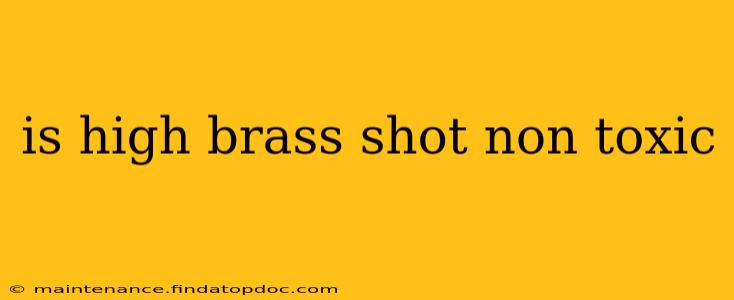The question of whether high brass shot is non-toxic is complex and requires a nuanced answer. It hinges on understanding what constitutes "high brass" and the types of shot used within that cartridge. Simply put, the "high brass" designation refers to the cartridge casing, not the shot itself. Let's break it down:
What Does "High Brass" Mean?
"High brass" describes shotgun shells with a longer, thicker, and typically more rigid brass casing. This construction is often associated with higher pressures and faster shot velocities. However, it says nothing about the material of the shot itself. The shot could be lead, steel, bismuth, or other materials. The casing simply holds the powder and the projectile.
What Types of Shot Are Used in High Brass Shells?
This is where the toxicity question becomes crucial. Historically, most shotgun shells used lead shot, which is highly toxic to wildlife and the environment. Lead shot ingestion can be fatal for waterfowl, and even small amounts can lead to bioaccumulation in the food chain. However, due to environmental concerns, many jurisdictions have banned or restricted the use of lead shot for hunting certain game, particularly waterfowl.
This has led to the development of various non-toxic alternatives, including:
- Steel shot: A widely used, cost-effective alternative to lead. While less dense than lead, it's effective for many hunting situations, though it can be harder on shotgun barrels.
- Bismuth shot: A denser, more effective alternative than steel, but significantly more expensive.
- Tungsten-iron shot: A very dense shot, providing excellent performance, but also very expensive.
- Other alternatives: Various other materials are also used, including various alloys and polymer-based shots.
So, Is High Brass Shot Always Non-Toxic?
No. High brass shells can contain either toxic or non-toxic shot. The "high brass" designation only refers to the shell casing, not the material of the shot pellets. To determine if a specific high brass shell is non-toxic, you must check the packaging for information about the shot material. Look for explicit labeling stating "non-toxic" or indicating the type of shot used (e.g., steel, bismuth).
Is high brass shot better than low brass?
The "high brass" versus "low brass" designation primarily indicates the shell's construction and intended use. High brass shells usually have higher pressures, faster velocities, and are typically used for hunting larger game or longer-range shooting. Low brass shells are often used for target shooting and smaller game. Neither inherently implies toxicity or non-toxicity. The shot material is the determining factor.
What are the environmental impacts of lead shot?
Lead shot poses a significant environmental threat, especially to waterfowl and other wetland species. Lead shot fragments can accumulate in the soil and water, posing a risk of ingestion by animals. This can lead to lead poisoning, reproductive problems, and mortality. The use of non-toxic shot is crucial to protecting wildlife and the environment.
How can I choose non-toxic shotgun ammunition?
Always check the packaging for clear labeling indicating the shot type. Look for "non-toxic" designations and information specifying the shot material (steel, bismuth, etc.). Many manufacturers clearly label their products to meet environmental regulations and consumer demand for responsible hunting practices.
In conclusion, the term "high brass" is not an indicator of toxicity. The material of the shot pellets determines whether the ammunition is environmentally safe. Always carefully examine the packaging to ensure you're using non-toxic shot, especially when hunting waterfowl or in areas where lead shot is restricted or banned.
